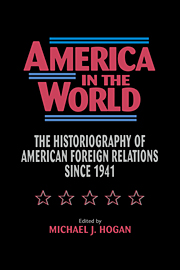Book contents
- Frontmatter
- Contents
- Preface
- The Authors
- Part One The State of the Art
- Part Two The Historiography of American Foreign Relations since 1941
- 6 The Historiography of American Foreign Relations: An Introduction
- 7 A Half-Century of Conflict: Interpretations of U.S. World War II Diplomacy
- 8 The Decision to Use the Bomb: A Historiographical Update
- 9 Origins of the Cold War in Europe and the Near East: Recent Historiography and the National Security Imperative
- 10 Making Known the Unknown War: Policy Analysis of the Korean Conflict since the Early 1980s
- 11 Eisenhower Revisionism: The Scholarly Debate
- 12 John F. Kennedy as World Leader: A Perspective on the Literature
- 13 The Unending Debate: Historians and the Vietnam War
- 14 Complaints, Self-Justifications, and Analysis: The Historiography of American Foreign Relations since 1969
- 15 An Emerging Synthesis? U.S.–Latin American Relations since the Second World War
- 16 Gideon's Band: America and the Middle East since 1945
- 17 The Cold War in Asia: The Elusive Synthesis
- 18 The Power of Money: The Historiography of American Economic Diplomacy
- 19 Coming in from the Cold War: The Historiography of American Intelligence, 1945–1990
- Index
19 - Coming in from the Cold War: The Historiography of American Intelligence, 1945–1990
Published online by Cambridge University Press: 05 June 2012
- Frontmatter
- Contents
- Preface
- The Authors
- Part One The State of the Art
- Part Two The Historiography of American Foreign Relations since 1941
- 6 The Historiography of American Foreign Relations: An Introduction
- 7 A Half-Century of Conflict: Interpretations of U.S. World War II Diplomacy
- 8 The Decision to Use the Bomb: A Historiographical Update
- 9 Origins of the Cold War in Europe and the Near East: Recent Historiography and the National Security Imperative
- 10 Making Known the Unknown War: Policy Analysis of the Korean Conflict since the Early 1980s
- 11 Eisenhower Revisionism: The Scholarly Debate
- 12 John F. Kennedy as World Leader: A Perspective on the Literature
- 13 The Unending Debate: Historians and the Vietnam War
- 14 Complaints, Self-Justifications, and Analysis: The Historiography of American Foreign Relations since 1969
- 15 An Emerging Synthesis? U.S.–Latin American Relations since the Second World War
- 16 Gideon's Band: America and the Middle East since 1945
- 17 The Cold War in Asia: The Elusive Synthesis
- 18 The Power of Money: The Historiography of American Economic Diplomacy
- 19 Coming in from the Cold War: The Historiography of American Intelligence, 1945–1990
- Index
Summary
A new branch of history has arisen: the study of intelligence. Not that the topic has ever been ignored. In most decades of this century, some scholars referred to intelligence, their works augmented by a few semi-official accounts and a good many bad books. Diplomatic and military historians often discussed espionage and used it for purposes of evidence or explanation. In Russia and the Balkans, 1870–1880 (1937), for example, B. H. Sumner integrated intelligence and diplomacy as well as any subsequent writer. Meanwhile, beginning in the later nineteenth century, the genre of spy fiction began to flourish. Old-hands-turned-hacks like Somerset Maugham, Ian Fleming, and E. Howard Hunt shaped that genre and general views about espionage: They publicized the secret services.
The number of works, scholarly and popular, that referred to intelligence began to rise around 1960; in the early 1970s began a flood. The decision of Her Majesty's Government to release some – not all – of its records about “Ultra” during the Second World War transformed public attitudes as “Magic” never had. So, too, did the era of angst in the United States that culminated in the Watergate scandal. The secret world suddenly seemed central to the real world. It also became accessible to the public. Much material about contemporary American intelligence was released through congressional committees, while the number of journalists interested in the field and old hands willing to speak about their careers increased.
- Type
- Chapter
- Information
- America in the WorldThe Historiography of US Foreign Relations since 1941, pp. 562 - 598Publisher: Cambridge University PressPrint publication year: 1996
- 2
- Cited by



